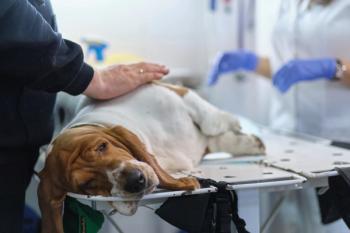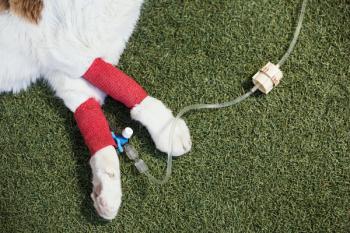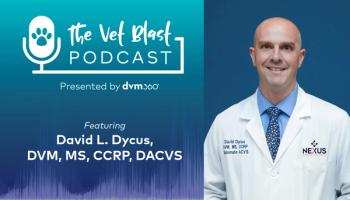
When emergencies strike, are you ready?
Recognized as a pioneer in small-animal emergency and critical-care medicine, Rebecca Kirby, DVM, Dipl. ACVIM, Dipl. ACVECC, offers advice to practitioners on handling emergency situations. She sat down with DVM Newsmagazine for a recent Q/A session.
Recognized as a pioneer in small-animal emergency and critical-care medicine, Rebecca Kirby, DVM, Dipl. ACVIM, Dipl. ACVECC, offers advice to practitioners on handling emergency situations. She sat down with DVM Newsmagazine for a recent Q/A session.
Kirby is executive director and director of education of the Animal Emergency Center, a 24-hour emergency and critical-care referral center in Glendale, Wis.
DVM: You have devoted a career to practicing emergency medicine. What intrigues you about the discipline?
Kirby: For one, you have to be on your toes. The practice of emergency medicine involves all body systems. It also involves medicine, surgery and anesthesia. It's always exciting. No two days are ever the same. And you can never say that you're bored. What makes it fascinating on a daily basis is everything from the people you meet to the animals you treat.
DVM: What advice would you offer practitioners who are presented with an animal after a life-threatening accident?
Kirby: It all depends on the practitioner's level of comfort in dealing with critical patients. If they're not all that comfortable, I would recommend they call the closest facility and seek advice on what to do before transport.
If the practitioner has a level of comfort in handling the situation, he or she would want to get the animal stable as quickly as possible. Next, they need to get in touch with a specialist. I've found that, because emergency care is so specialized and the whole base of daytime practice is so much broader, the majority of practitioners don't feel as comfortable giving acute life-saving care. Therefore, my best advice: Call an emergency facility. In some instances the nearest one might be an hour away. Often we'll get calls from those facilities on what they should do. We're comfortable fielding those calls and offering some direction.
DVM: When an animal is released from care after an emergency, is wound-care compliance a concern?
Kirby: Yes, wound-care compliance is always a concern. We handle that primarily through the referring veterinarian. Depending on how extensive the case is, the client may bring the animal back to see our specialists for re-checks. If it's something their veterinarian is comfortable doing, such as follow-through, we expect the veterinarian to handle the compliance. In general, I can say that primary-care veterinarians are usually very diligent with compliance.
DVM: What makes up most of your emergency caseload (e.g., trauma, geriatric patients, etc.)?
Kirby: The bulk is going to be metabolic — vomiting, diarrhea, diabetes, if you look at cases over a whole year. Traumas are quite seasonal — from my days at Penn to here. As you might expect, there are not as many hit-by-car incidents in January and February as there are in July and August.
DVM: Are most private practitioners equipped to handle emergencies?
Kirby: It all goes back to the comfort level of the practitioner and how familiar they are with emergency situations. In some cases, they may have all the necessary equipment but have not seen a true emergency for five years. So one's comfort level may not be great. Another practitioner might say, 'I'm totally comfortable with handling emergencies, but we don't have the equipment.' The thing about emergencies that practitioners must realize is that they are very time-consuming. Most veterinarians have a very packed schedule. Although in many cases they may be quite capable, they simply may not have time.
DVM: What advice could you offer general practitioners about referral and transport of animals after emergencies?
Kirby: Whenever possible, call and see what the emergency facility suggests prior to transfer. The primary goal is to get them here fast. They may have the opportunity to save a life if they give the animal some ethanol in a case where it has ingested antifreeze. See if there's anything they can do quickly, prior to transport.
DVM: Any myths about emergency medicine that you'd like to bust?
Kirby: First, I would say that very few emergency facilities are "Band-Aid" stations. That's pretty much a myth now. With today's standards, veterinarians devoted to emergency medicine are dedicated to that for their career. We also have sufficient CE in the field. A lot of people really don't understand what a specialist in emergency care can provide. It is something that still needs to be learned.
Emergency medicine is going to continue to grow, especially in terms of the number of people interested and who enjoy doing it. I view veterinary emergency medicine as being a leader in increasing standards of care even on the human side.
To date, animal emergency medicine has been a frontrunner and leader in equipment and knowledge base and trying new drugs and procedures, because they're much more able to test on animals than would be the case for humans.
Trying something new is well tolerated by owners, because of the prognosis if you don't. We have the opportunity to find the best way to do a procedure by trying to see if something will work. That opportunity will become more readily available because of the nature of our type of practice. However, in many cases, we also mirror what's happening on the human side, if we're not ahead of the curve.
With a specialty college in emergency critical care, we have enough veterinarians to keep us up to speed. We are able to do certain procedures and, in the case of oxyglobin, have used it much more in veterinary emergencies than the human side has used it.
DVM: Could you share a health tip about emergency medicine for general practitioners?
Kirby: The No. 1 area in which people call with questions is fluid resuscitation. For general practitioners who are comfortable with shock and use of colloids, having a bag is a great thing. In the operating room, if the patient gets hypertensive, fluid therapy is the mainstay of all medicine. Practitioners in general are used to treating animals that are in healthier condition than what an emergency clinician might see.
Bio brief
Rebecca Kirby, DVM,
Dipl. ACVIM, Dipl. ACVECC
- Owner, executive director and director of education of the Animal Emergency Center, a 24-hour emergency and critical-care referral center in Glendale, Wis.
- Associate professor of emergency medicine and director of emergency services at the University of Pennsylvania School of Veterinary Medicine.
- Created the first residency-training program in the world in emergency and critical care, and has trained more than 20 residents in the specialty.
Newsletter
From exam room tips to practice management insights, get trusted veterinary news delivered straight to your inbox—subscribe to dvm360.



